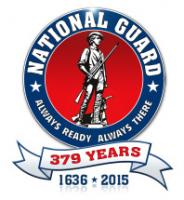By The National Guard Public Affairs Office
Dec. 13, 2015, marks the 379th birthday of the National Guard.
On that day in 1636, the first militia regiments in North America were organized in Massachusetts. Based upon an order of the Massachusetts Bay Colony’s General Court, the colony’s militia was organized into three permanent regiments
to better defend the colony. Today, the descendants of these first regiments – the 181st Infantry, the 182nd Infantry, the 101st Field Artillery, and the 101st Engineer Battalion of the Massachusetts
Army National Guard – share the distinction of being the oldest units in the U.S. military.
The National Guard is the oldest military force in the Department of Defense, and is uniquely characterized by the dual state-federal organization that divided the militia power and its importance in the U.S. Constitution.
Throughout history, the Guard has been a trusted, reliable force that is “Always Ready, Always There.” Most days, Guard service members are working civilians in the community who could be the mechanic fixing car brakes or a tax accountant. Quite often, the experiences and knowledge gained as civilians in the community are skills Guard members take back to duty stations all over the world.
Guard service members are dispersed across 3,000 communities nationwide. They typically act as the first military responders to domestic emergencies. When Americans need their military, most often they reach out to the National Guard.
- In the 2015 Fiscal Year, Army and Air National Guard members were called-up by their governors 286 times and logged 547,111 man days responding to homeland emergencies.
- Guard forces responded to 117 search and rescue, 53 explosive ordnance disposal, 53 natural disasters, and 27 structure fires missions. Most the natural disaster responses involved 28 wild fires, 8 floods, 7 winter storms, and 6 tropical storms and hurricanes.
- The National Guard has 10 Homeland Response Forces (HRFs), one in each of the 10 FEMA regions, with 577 personnel each providing lifesaving capabilities within 6-12 hours of a chemical, biological radiological, nuclear event.
- For more than 20 years, through the State Partnership Program (SPP), the National Guard has had 70 partnerships with one-third of the world’s countries. In the last 10 years, 28 SPP partner countries have deployed forces to Iraq and/or Afghanistan. Fifteen of those nations co-deployed with state National Guard forces 79 times to those conflicts.
- Air National Guard fighter pilots and ground crews exclusively guard our skies, defending U.S. and Canadian air space at strategic sites nationwide.
- Since July 2010, Guard personnel have augmented security activities for U.S. Immigration and Customs Enforcement on the Southwest Border.
- At U.S. Army Garrison Stuttgart, there are currently have over 30 Army and Air National Guardsman serving key positions in both major commands from the ranks of Sergeant First Class to Major General.
The National Guard in its federal role has contributed to every conflict since our nation’s birth in support of worldwide combat, humanitarian, and security cooperation operations.
- In 1940, with World War Two raging in Europe, President Franklin D. Roosevelt ordered the National Guard of the United States into active service. In less than a year, the National Guard brought into federal service more than 300,000 men, doubling the size of the regular army. During the war, National Guard units participated in 34 separate campaigns and numerous assault landings in the European and Pacific theaters of Operation. Of the first five U.S. Army divisions to enter offensive combat, four of them were Guard divisions. One Guard division, the 29th, participated in the Omaha Beach D-Day landings.
- The Korean War brought more than 183,000 Army and Air Guard members to active duty. Army Guard units included eight infantry divisions and three regimental combat teams. The Air Guard call-up included 67 flying squadrons. Approximately 45,000 Air Guardsmen were mobilized, comprising 80 percent of the force.
- While there were no large call-ups of National Guard during Vietnam, eleven Air National Guard units were ordered to active duty following the seizure of the U.S.S. Pueblo by the North Koreans. The Communists’ Tet Offensive in South Vietnam during February 1968 led to another limited mobilization in March 1968. The second mobilization included two Air National Guard fighters and one aero- medical evacuation unit. More than 10,000 Air Guardsmen were called to active duty during the two mobilizations. Also ordered to active duty in May 1968 were 20 units of the Army National Guard.
Nearly half of Guard members today are combat veterans. Some are veterans two, three, four times over. During the past 14 years of conflict, hundreds of National Guard members paid the ultimate sacrifice for our nation.
While much has changed since the beginnings during the 17th Century, in the face of today’s national security and fiscal challenges, the National Guard remains a proven and trusted force that is accessible, adaptable, and affordable.
